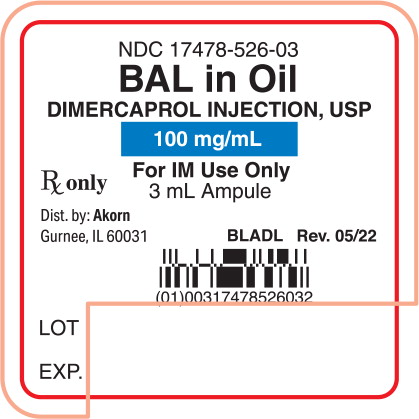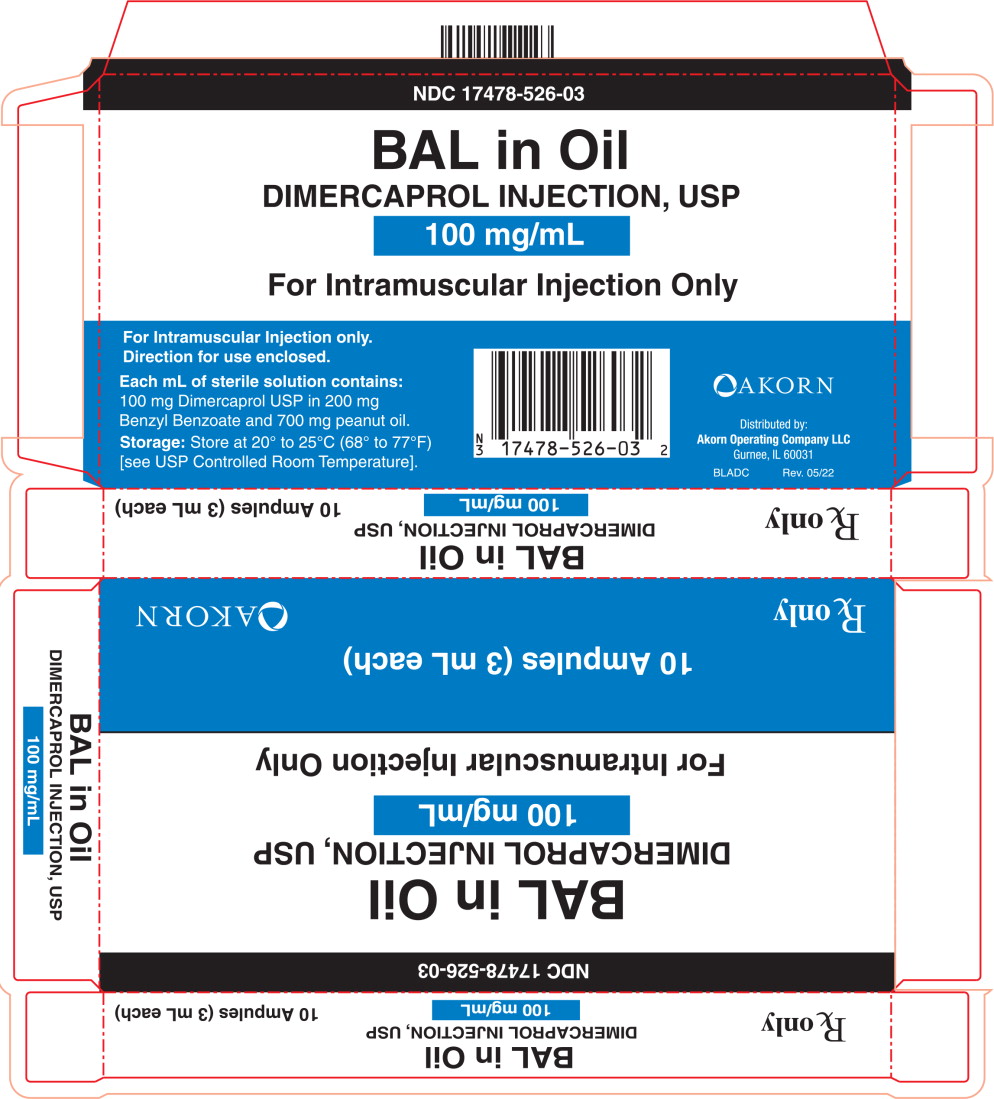BAL Dailymed
Generic: dimercaprol is used for the treatment of Cadmium Poisoning Lead Poisoning Liver Diseases Arsenic Poisoning Mercury Poisoning, Nervous System
Go PRO for all pill images
BAL (2,3-dimercapto-1-propanol) 10%, Benzyl Benzoate 20%, in Peanut Oil

Rx only
Description
Dimercaprol Injection USP is a colorless or almost colorless liquid chelating agent having a disagreeable, mercaptan-like odor. Each 1 mL sterile BAL in Oil (Dimercaprol Injection USP) contains: 100 mg Dimercaprol in 200 mg Benzyl Benzoate and 700 mg Peanut Oil.
Clinical Pharmacology
The sulfhydryl groups of dimercaprol form complexes with certain heavy metals thus preventing or reversing the metallic binding of sulfhydryl-containing enzymes. The complex is excreted. The sustained presence of dimercaprol promotes continued excretion of the metallic poisons - arsenic, gold and mercury. It is also used in combination with Edetate Calcium Disodium Injection USP to promote the excretion of lead.
Indications
BAL in Oil (Dimercaprol Injection USP) is indicated in the treatment of arsenic, gold and mercury poisoning. It is indicated in acute lead poisoning when used concomitantly with Edetate Calcium Disodium Injection USP.
Dimercaprol Injection USP is effective for use in acute poisoning by mercury salts if therapy is begun within one or two hours following ingestion. It is not very effective for chronic mercury poisoning.
Dimercaprol Injection USP is of questionable value in poisoning caused by other heavy metals such as antimony and bismuth. It should not be used in iron, cadmium, or selenium poisoning because the resulting dimercaprol-metal complexes are more toxic than the metal alone, especially to the kidneys.
Contraindications
BAL in Oil (Dimercaprol Injection USP) is contraindicated in most instances of hepatic insufficiency with the exception of postarsenical jaundice. The drug should be discontinued or used only with extreme caution if acute renal insufficiency develops during therapy.
Warnings
There may be local pain at the site of the injection. A reaction apparently peculiar to children is fever which may persist during therapy. It occurs in approximately 30% of children. A transient reduction of the percentage of polymorphonuclear leukocytes may also be observed.
Precautions
Because the dimercaprol-metal complex breaks down easily in an acid medium, production of an alkaline urine affords protection to the kidney during therapy. Medicinal iron should not be administered to patients under therapy with BAL in Oil (Dimercaprol Injection USP).
BAL in Oil Ampules is formulated with peanut oil. Peanut oil may cause allergic reactions in some individuals. Physicians should use caution in prescribing BAL in Oil Ampules for peanut-sensitive patients. Medication and equipment necessary to treat allergic reactions should be available if the product is administered to peanut-allergic patients.
Pregnancy Category C
Animal reproduction studies have not been conducted with BAL in Oil. It is also not known whether BAL in Oil can cause fetal harm when administered to a pregnant woman, or can affect reproduction capacity. BAL in Oil should be given to a pregnant woman only if clearly needed.
It is not known whether this drug is excreted in human milk. However, because many drugs are excreted in human milk, caution should be exercised when BAL in Oil is administered to a nursing woman.
Adverse Reactions
One of the most consistent responses to Dimercaprol Injection USP is a rise in blood pressure accompanied by tachycardia. This rise is roughly proportional to the dose administered. Doses larger than those recommended may cause other transitory signs and symptoms in approximate order of frequency as follows: (1) nausea and, in some instance, vomiting; (2) headache; (3) a burning sensation in the lips, mouth and throat; (4) a feeling of constriction, even pain, in the throat, chest, or hands; (5) conjunctivitis, lacrimation, blepharal spasm, rhinorrhea, and salivation; (6) tingling of the hands; (7) a burning sensation in the penis; (8) sweating of the forehead, hands and other areas; (9) abdominal pain; and (10) occasional appearance of painful sterile abscesses. Many of the above symptoms are accompanied by a feeling of anxiety, weakness, and unrest and often are relieved by administration of antihistamine.
Drug Abuse And Dependence
Dimercaprol Injection USP is not a controlled substance uled in any other Drug Enforcement Administration schedules. Its use is not known to lead to dependence or abuse.
Overdose
Dosage exceeding 5 mg/kg will usually be followed by vomiting, convulsions and stupor, beginning within 30 minutes and subsiding within 6 hours following injection.
AMER. HOSP. FORM. SERV., 64:00, Amer. Soc. Hosp. Pharm., 1977.
Dosage And Administration
By deep intramuscular injection only. For mild arsenic or gold poisoning, 2.5 mg/kg of body weight four times daily for two days, two times on the third day, and once daily thereafter for ten days; for severe arsenic or gold poisoning, 3 mg/kg every four hours for two-days, four times on the third day, then twice daily thereafter for ten days. For mercury poisoning, 5 mg/kg initially, followed by 2.5 mg/kg one or two times daily for ten days. For acute lead encephalopathy, 4 mg/kg body weight is given alone in the first dose and thereafter at four-hour intervals in combination with Edetate Calcium Disodium Injection USP administered at a separate site. For less severe poisoning the dose can be reduced to 3 mg/kg after the first dose. Treatment is maintained for two to seven days depending on clinical response. Successful treatment depends on beginning injections at the earliest possible moment and on the use of adequate amounts at frequent intervals. Other supportive measures should always be used in conjunction with BAL in Oil (Dimercaprol Injection USP) therapy.
BAL in Oil should be inspected visually for particulate matter and discoloration prior to administration.
How Supplied
3 mL (100 mg/mL) ampules, box of 10 (NDC 17478-526-03).
STORAGE AND HANDLING SECTION
STORAGE: Store at 20° to 25°C (68° to 77°F) [see USP Controlled Room Temperature].
Animal Toxicology
The intramuscular LD50 in rats is approximately 105 mg/kg; intraperitoneally 140 mg/kg. The intraperitoneal LD80 in mice is approximately 125 mg/kg.
JR. PHARM. EXPER. THER., 87, Supplement Aug. 1946.
Akorn
Distributed by: Akorn Operating Company LLC Gurnee, IL 60031
BL00N Rev. 05/22
Package Label.principal Display Panel
Principal Display Panel Text for Container Label:
NDC 17478-526-03BAL in OilDIMERCAPROL INJECTION, USP100 mg/mLFor IM Use OnlyRx only 3 mL Ampule

Package Label.principal Display Panel
Principal Display Panel Text for Carton Label:
NDC 17478-526-03BAL in OilDIMERCAPROL INJECTION, USP100 mg/mLFor Intramuscular Injection Only 10 Ampules (3 mL each)Rx only Akorn Logo

DISCLAIMER:
"This tool does not provide medical advice, and is for informational and educational purposes only, and is not a substitute for professional medical advice, treatment or diagnosis. Call your doctor to receive medical advice. If you think you may have a medical emergency, please dial 911."
"Do not rely on openFDA to make decisions regarding medical care. While we make every effort to ensure that data is accurate, you should assume all results are unvalidated. We may limit or otherwise restrict your access to the API in line with our Terms of Service."
"This product uses publicly available data from the U.S. National Library of Medicine (NLM), National Institutes of Health, Department of Health and Human Services; NLM is not responsible for the product and does not endorse or recommend this or any other product."
PillSync may earn a commission via links on our site

